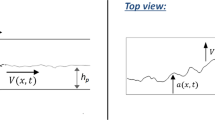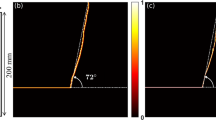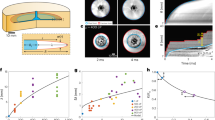Abstract
As the speed of a crack propagating through a brittle material increases, a dynamical instability leads to an increased roughening of the fracture surface. Cracks moving at low speeds create atomically flat mirror-like surfaces; at higher speeds, rougher, less reflective (‘mist’) and finally very rough, irregularly faceted (‘hackle’) surfaces1,2,3,4,5 are formed. The behaviour is observed in many different brittle materials, but the underlying physical principles, though extensively debated, remain unresolved1,2,3,4. Most existing theories of fracture6,7,8,9,10,11,12 assume a linear elastic stress–strain law. However, the relation between stress and strain in real solids is strongly nonlinear due to large deformations near a moving crack tip, a phenomenon referred to as hyperelasticity13,14,15,16,17. Here we use massively parallel large-scale atomistic simulations—employing a simple atomistic material model that allows a systematic transition from linear elastic to strongly nonlinear behaviour—to show that hyperelasticity plays a governing role in the onset of the instability. We report a generalized model that describes the onset of instability as a competition between different mechanisms controlled by the local stress field6,7,8 and local energy flow13,14 near the crack tip. Our results indicate that such instabilities are intrinsic to dynamical fracture and they help to explain a range of controversial experimental1,2,3,4,5,18 and computational19,20,21,22,23,24,25,26 results.
This is a preview of subscription content, access via your institution
Access options
Subscribe to this journal
Receive 51 print issues and online access
$199.00 per year
only $3.90 per issue
Buy this article
- Purchase on Springer Link
- Instant access to full article PDF
Prices may be subject to local taxes which are calculated during checkout




Similar content being viewed by others
References
Fineberg, J., Gross, S. P., Marder, M. & Swinney, H. L. Instability in dynamic fracture. Phys. Rev. Lett. 67, 141–144 (1991)
Marder, M. & Gross, S. Origin of crack-tip instabilities. J. Mech. Phys. Solids 43, 1–48 (1995)
Ravi-Chandar, K. Dynamic fracture of nominally brittle materials. Int. J. Fract. 90, 83–102 (1998)
Hauch, J. A., Holland, D., Marder, M. P. & Swinney, H. L. Dynamic fracture in single crystal silicon. Phys. Rev. Lett. 82, 3823–3826 (1999)
Cramer, T., Wanner, A. & Gumbsch, P. Energy dissipation and path instabilities in dynamic fracture of silicon single crystals. Phys. Rev. Lett. 85, 788–791 (2000)
Freund, L. B. Dynamic Fracture Mechanics 2nd edn (Cambridge Univ. Press, Cambridge, UK, 1998)
Broberg, B. Cracks and Fracture (Academic, San Diego, 1999)
Yoffe, E. H. The moving Griffith crack. Phil. Mag. 42, 739–750 (1951)
Slepyan, L. I. Models and Phenomena in Fracture Mechanics (Springer, Berlin, 2002)
Eshelby, J. D. Fracture mechanics. Sci. Prog. 59, 161–179 (1971)
Freund, L. B. Crack propagation in an elastic solid subject to general loading. IV. Obliquely incident stress pulse. J. Mech. Phys. Solids 22, 137–146 (1974)
Gao, H. Surface roughening and branching instabilities in dynamic fracture. J. Mech. Phys. Solids 41, 457–486 (1993)
Gao, H. A theory of local limiting speed in dynamic fracture. J. Mech. Phys. Solids 44, 1453–1474 (1996)
Gao, H. Elastic eaves in a hyperelastic solid near its plane-strain equibiaxial cohesive limit. Phil. Mag. Lett. 76, 307–314 (1997)
Guo, G. F., Yang, W. & Huang, Y. Supersonic crack growth in a solid of upturn stress-strain relation under anti-plane shear. J. Mech. Phys. Solids 51, 1971–1985 (2003)
Buehler, M. J., Abraham, F. F. & Gao, H. Hyperelasticity governs dynamic fracture at a critical length scale. Nature 426, 141–146 (2003)
Buehler, M. J., Abraham, F. F. & Gao, H. in Multiscale Modeling and Simulation (eds Attinger, S. & Koumoutsakos, P.) 143–156 (Springer Lecture Notes in Computational Science and Engineering, Springer, Berlin, 2004)
Petersan, P. J., Deegan, R. D., Marder, M. & Swinney, H. L. Cracks in rubber under tension exceed the shear wave speed. Phys. Rev. Lett. 93, 015504 (2004)
Abraham, F. F., Brodbeck, D., Rudge, W. E. & Xu, X. Instability of fracture—a computer-simulation investigation. Phys. Rev. Lett. 73, 272–275 (1994)
Abraham, F. F., Brodbeck, D., Rudge, W. E. & Xu, X. A molecular-dynamics investigation of rapid fracture mechanics. J. Mech. Phys. Solids 45, 1595–1619 (1997)
Gumbsch, P., Zhou, S. J. & Holian, B. L. Molecular-dynamics investigation of dynamic crack tip instability. Phys. Rev. B 55, 3445–3455 (1997)
Fineberg, J. & Marder, M. Instability in dynamic fracture. Phys. Rep. Rev. Phys. Lett. 313(1–2), 2–108 (1999)
Swadener, J. G., Baskes, M. I. & Nastasi, M. Molecular dynamics simulation of brittle fracture in silicon. Phys. Rev. Lett. 89, 085503 (2002)
Rountree, C. L. et al. Atomistic aspects of crack propagation in brittle materials: Multimillion atom molecular-dynamics simulations. Annu. Rev. Mater. Res. 32, 377–400 (2002)
Heizler, S. I., Kessler, D. A. & Levine, H. Mode I fracture in a nonlinear lattice with viscoelastic forces. Phys. Rev. E 66, 016126 (2002)
Abraham, F. F. Unstable crack motion is predictable. J. Mech. Phys. Solids 53, 1071–1078 (2005)
Boresi, A. & Chong, K. P. Elasticity in Engineering Mechanics 2nd edn (Wiley-Interscience, New York, 2000)
Allen, M. & Tildesley, D. Computer Simulation of Liquids (Oxford Univ. Press, New York, 1989)
van Duin, A. C. T. et al. ReaxFFSiO reactive force field for silicon and silicon oxide systems. J. Phys. Chem. A 107, 3803–3811 (2003)
Zhou, M. A new look at the atomic level virial stress: on continuum-molecular system equivalence. Proc. R. Soc. A 459, 2347–2392 (2003)
Acknowledgements
We acknowledge discussions with F. F. Abraham on atomistic modelling of dynamic fracture.
Author information
Authors and Affiliations
Corresponding author
Ethics declarations
Competing interests
Reprints and permissions information is available at npg.nature.com/reprintsandpermissions. The authors declare no competing financial interests.
Supplementary information
Supplementary Notes
This file contains background information on important questions in the field of dynamical fracture, introducing classical theories, major experimental results and a summary of the concept of hyperelasticity. (PDF 118 kb)
Supplementary Methods
This file contains an introduction into the molecular dynamics simulation procedure and details about the simulation geometry used for the studies reported in this Letter. (PDF 117 kb)
Supplementary Figure
The concept of dynamical crack tip instabilities and nonlinear elasticity. (PDF 326 kb)
Rights and permissions
About this article
Cite this article
Buehler, M., Gao, H. Dynamical fracture instabilities due to local hyperelasticity at crack tips. Nature 439, 307–310 (2006). https://doi.org/10.1038/nature04408
Received:
Accepted:
Issue Date:
DOI: https://doi.org/10.1038/nature04408
This article is cited by
-
Acoustic emission response of a finite crack in plate structure under moving point heating source
Journal of the Brazilian Society of Mechanical Sciences and Engineering (2023)
-
Experimentally measuring weak fracture toughness anisotropy in graphene
Communications Materials (2022)
-
Intrinsic toughening and stable crack propagation in hexagonal boron nitride
Nature (2021)
-
Peridynamic analysis of dynamic fracture: influence of peridynamic horizon, dimensionality and specimen size
Computational Mechanics (2021)
-
Inter-granular fracture behaviour in bicrystalline boron nitride nanosheets using atomistic and continuum mechanics-based approaches
Journal of Materials Science (2021)
Comments
By submitting a comment you agree to abide by our Terms and Community Guidelines. If you find something abusive or that does not comply with our terms or guidelines please flag it as inappropriate.



